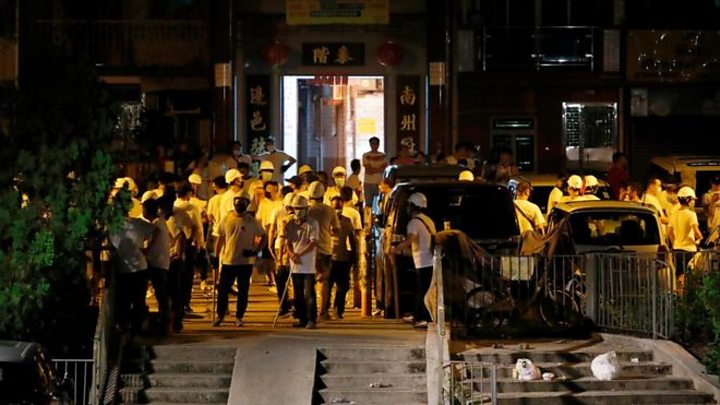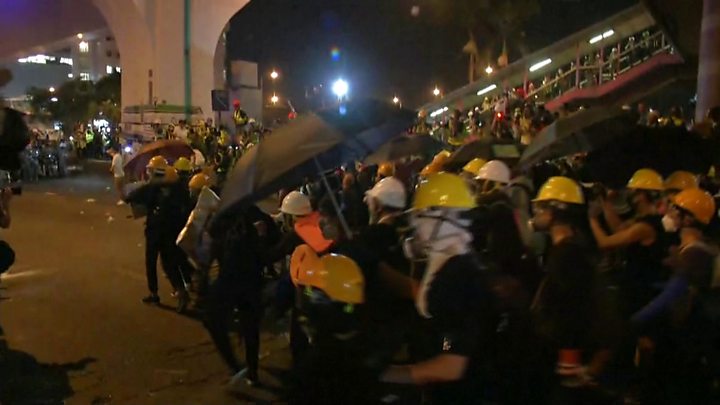Hong Kong protests: Armed mob violence leaves city in shock

Media playback is unsupported on your device
Hong Kong has been left in shock after a night of violence on Sunday, which saw dozens of masked men storm a train station.
The men – dressed in white shirts and suspected to be triad gangsters – assaulted pro-democracy protesters and passers-by in the Yuen Long area.
This is the first time this kind of violence has been seen in the ongoing anti-extradition demonstrations.
Several lawmakers questioned why police were slow to arrive at the scene.
Footage posted on social media showed dozens of men attacking people with wooden rods and metal sticks inside the station.
Forty-five people were injured, with one person in critical condition.
Hong Kong’s Chief Executive Carrie Lam told reporters the gang attacks were “shocking”. She also condemned protesters for defacing China’s main representative office in the city earlier on Sunday.
What happened?
Pro-democracy protesters were set upon as they travelled back from a rally in the centre of Hong Kong, where riot police had fired tear gas and rubber bullets at protesters.
The masked men stormed Yuen Long MTR station at about 22:30 local time (14:30 GMT).
Local media said they were targeting people dressed in black – the colour most protesters were wearing.
In a statement, the government said: “This is absolutely unacceptable to Hong Kong as a society that observes the rule of law. The SAR [Special Administrative Region] Government strongly condemns any violence and will seriously take enforcement actions.”
One journalist, Gwyneth Ho, was attacked while she was in the middle of live streaming for news website Stand News. She is currently in hospital.
The Hong Kong Journalist Association said some reporters on the scene had equipment seized.
Who are the men?
It is not known who organised the attack.
Opposition lawmaker Lam Cheuk-ting suggested the mob had ties to organised crime syndicates.
“Is Hong Kong now allowing triads to do what they want, beating up people on the street with weapons?” he asked reporters.
Another pro-democracy lawmaker, Ray Chan, tweeted a complaint about the police response. “Hong Kong has one of the world’s highest cop to population ratio … Where were [they?]”
Video footage also surfaced of pro-Beijing lawmaker Junius Ho, shaking hands with men in white and giving them the thumbs-up signal.
On Facebook, he denied a connection with the men and said he was just responding to their greetings when they recognised him on the street after he left a restaurant.
Police on Monday said they had not made any arrests but were still carrying out investigations.
Some of the assailants did not seem too concerned about masking their identity, posting selfies online, before during and after the attack, reported the BBC’s China correspondent Stephen McDonell.
On the streets of Yuen Long
By Martin Ching-Sze Yip, Hong Kong reporter
Yuen Long is a centuries-old farming and trading town, which has hugely expanded in recent decades. Most of its village leaders and their clans are pro-China.
On Sunday evening, people began to share photos online that showed coach loads of men in white shirts congregating in the area.
Later – after the train station attacks – many of these men were seen running back to the surrounding villages, intensifying speculation that they were backed by the locals, if not hired by them.
Pro-democracy demonstrators have now announced that they want to move a pre-planned rally to Yuen Long next Sunday as a reaction to the outburst of violence. Until now all rallies have been held more centrally, on Hong Kong Island.
One villager told me that local clans are concerned by the shift, as it feels like people are “messing around on their doorstep”. He said they consider the protesters to be thugs who need to be taught a lesson.
What led up to this?
Mass protests have been held for weeks, initially over an extradition deal with mainland China, which the Hong Kong government has since suspended.
The unrest has now spread to cover broader demands for democratic reform and reflect concerns that freedoms are being eroded.

Media playback is unsupported on your device
In a rare act, protesters defaced the liaison office, China’s central government building, on Sunday. One of the graffiti slogans read: “You taught us peaceful marches are useless.”
Ms Lam strongly condemned the vandalism by “radical demonstrators”, saying they had acted “maliciously” and “challenged the nation’s sovereignty”.
Some protesters also covered CCTV cameras outside a police station with spray paint.
Organisers of the protest say more than 430,000 people took part in the rally, but police put the figure at 138,000.
On Saturday a counter-rally, in support of the police and against protest violence, drew 300,000 people according to organisers and 103,000 people according to police.

Media playback is unsupported on your device
How did this wave of protests start?
They were sparked by the proposed extradition bill that would have allowed people to be sent to China for trial.
Critics said it would undermine Hong Kong’s judicial independence and could be used to target those who spoke out against the Chinese government.
The former British colony is part of China but run under a “one country, two systems” arrangement that guarantees it a level of autonomy. It has its own judiciary, and a legal system that is independent from mainland China.




